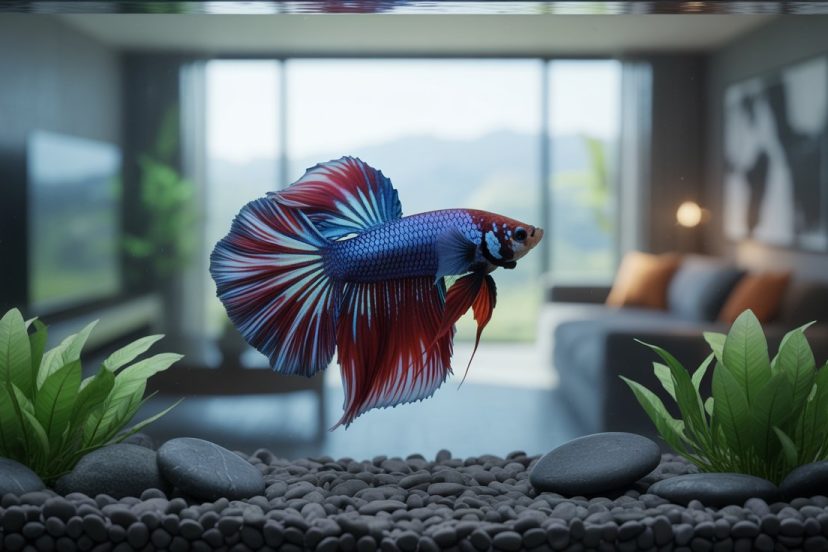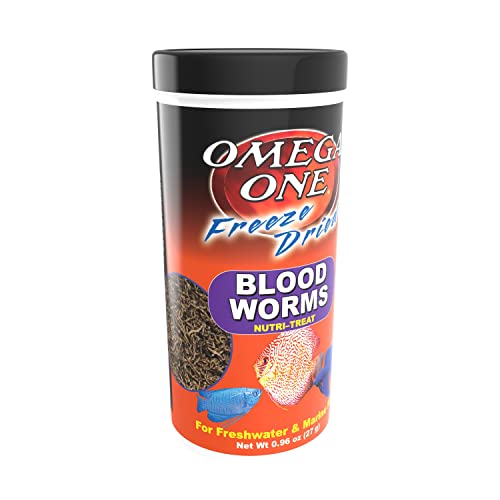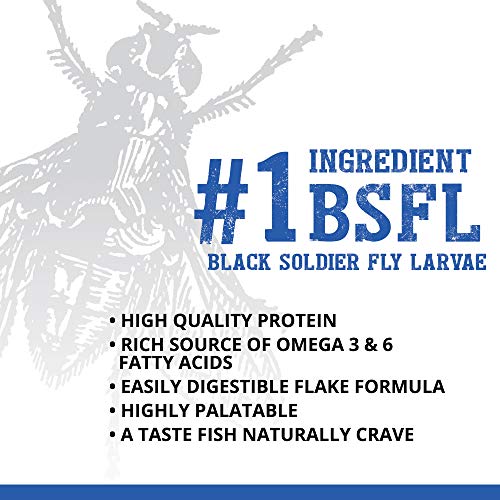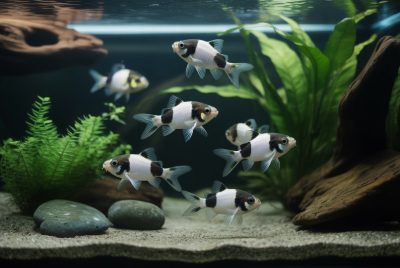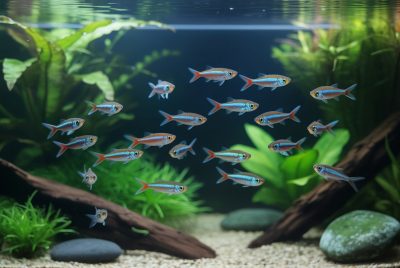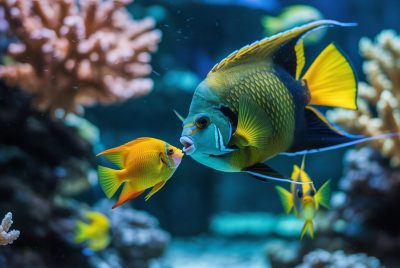How to Feed Betta Fish Properly (Dos and Don’ts)
*We may earn a commission for purchases made using our links. Please see our disclosure to learn more.
A betta fish floats motionless near the surface, its once-vibrant colors faded to dull shadows. The water is cloudy, and uneaten food particles drift along the gravel. This heartbreaking scene doesn’t result from neglect—it comes from too much care, specifically too much feeding. The difference between a thriving betta and a struggling one often comes down to understanding a simple truth: these fish don’t need as much food as their behavior suggests.
Betta fish are master manipulators, approaching the glass with eager eyes every time someone walks past the tank. That seemingly desperate behavior tricks countless keepers into overfeeding, creating a cascade of health problems that can shorten these beautiful fish’s lives. Learning to feed betta fish properly means unlearning common assumptions about pet care and embracing practices that may feel counterintuitive but align perfectly with these carnivorous fish’s biological needs. This comprehensive guide reveals the dos and don’ts of betta feeding, transforming confusion into confidence and creating routines that support vibrant, healthy fish.
“The most common mistake in betta care is overfeeding. These fish have stomachs approximately the size of their eye, yet many owners treat feeding time as a bonding ritual rather than a nutritional necessity.”
— Journal of Fish Biology Research
Key Takeaways
- Betta fish are carnivores requiring high-protein diets (40% minimum protein content)
- Feed adult bettas once or twice daily, only what they can consume in 2-3 minutes
- Overfeeding causes more health issues than underfeeding—bettas can survive up to 14 days without food
- Variety is crucial: rotate between pellets, frozen foods, and live foods for optimal health
- One fasting day per week helps prevent digestive issues and mimics natural feeding patterns
Recommended Products for Betta Fish Feeding
1. Hikari Betta Bio-Gold Baby Pellets
The Hikari Betta Bio-Gold Baby Pellets are scientifically formulated to meet the nutritional needs of young and adult bettas. Made with premium seafood proteins and color-enhancing nutrients, these pellets support vibrant color, healthy growth, and strong immune systems. Each pellet is perfectly sized for easy feeding and minimal waste — ideal for betta owners learning how to feed betta fish properly. This 3-pack bonus bundle offers long-lasting value, keeping your bettas healthy and active for weeks.
When learning how to feed betta fish, choosing the right food is crucial — and Hikari Betta Bio-Gold Baby Pellets make it easy. These nutrient-rich pellets are specially designed for bettas’ small mouths and unique dietary needs. They float slowly, encouraging natural feeding behavior while preventing waste buildup. The color-enhancing formula keeps your betta’s fins bright and healthy, while the balanced nutrition supports long-term vitality. For beginners and experienced aquarists alike, this 3-pack bonus bundle is a smart, reliable choice for daily betta feeding.
- Nutritional Value: Optimally balanced with vitamins, minerals, and protein for healthy bettas.
- Color Enhancement: Contains natural color enhancers to make your betta’s fins more vibrant.
- Convenience: Small, slow-sinking pellets designed to reduce mess and overfeeding.
- Pellet Size: May be too small for full-grown bettas if used as the only food source.
- Price: Slightly higher than generic betta food brands.
- Feeding Frequency: Can cloud water if overfed, requiring careful portion control.
2. Omega One Freeze-Dried Bloodworms
The Omega One Freeze Dried Blood Worms are a high-protein, nutrient-rich treat that helps bettas thrive. Packed with essential amino acids and natural fats, these bloodworms promote rapid growth, vibrant color, and overall vitality. Ideal for all life stages, they make a perfect supplement for bettas when learning how to feed betta fish the right way. Freeze-dried for safety and convenience, this premium food offers the nutritional benefits of live worms without the risk of parasites — ensuring clean, healthy feeding every time.
When discussing how to feed betta fish, it’s important to offer variety — and Omega One Freeze Dried Blood Worms are an excellent choice for occasional feeding. These worms provide a natural source of protein that enhances betta color and activity. As a treat, they stimulate natural hunting behavior while supporting muscle development. Use them 2–3 times per week along with high-quality pellets to keep your betta healthy, energetic, and well-fed. Perfect for hobbyists looking to balance nutrition and excitement in their betta’s diet.
- High Protein Content: Boosts energy and supports strong fin growth and color.
- Safe & Convenient: Freeze-dried to eliminate harmful bacteria and parasites.
- Palatability: Bettas love the natural taste, making it great for picky eaters.
- Supplement Only: Should be used with pellet food for a balanced diet.
- Water Clarity: May cloud water if not pre-soaked or overfed.
- Texture: Some bettas may prefer softer, frozen alternatives.
3. Fluval Bug Bites Betta Formula
The Fluval Bug Bites Color Enhancing Fish Food is a premium flake formula crafted specifically for betta fish. Made with sustainably sourced insect larvae and salmon, it delivers high-quality protein and essential nutrients for optimal color, energy, and health. Designed for small to medium bettas, the flakes provide easy digestion and maximum palatability. If you’re learning how to feed betta fish, Fluval Bug Bites offer a natural, nutrient-dense diet that mimics what bettas eat in the wild — ensuring bright colors, strong fins, and long-term vitality.
When covering how to feed betta fish, the Fluval Bug Bites Color Enhancing Flakes deserve mention as one of the best balanced daily foods. Formulated with insect larvae — a betta’s natural protein source — these flakes provide excellent nutrition while enhancing color vibrancy. They contain essential amino acids, vitamins, and omega fatty acids that support energy, immunity, and fin health. Ideal for everyday feeding, Fluval Bug Bites help bettas stay active, colorful, and resilient. Use them as a staple diet and complement with treats like bloodworms or daphnia for variety.
- Natural Ingredients: Made with black soldier fly larvae and salmon for superior nutrition.
- Color Enhancement: Rich in omega-3 and beta-carotene to boost fin and body coloration.
- Digestibility: Easy-to-eat flakes that reduce waste and support healthy digestion.
- Flake Form: May sink quickly, making it harder for surface-feeding bettas.
- Smell: Has a strong seafood scent that some owners might find unpleasant.
- Storage: Needs to be kept sealed to prevent moisture and spoilage.
4. Zoo Med Micro Floating Betta Banquet Food Block
The Zoo Med Betta Banquet Blocks are specially designed to provide consistent nutrition for betta fish while you’re away. Made with high-quality seafood proteins, calcium, and essential nutrients, these slow-release feeding blocks gradually dissolve in water, offering bettas a steady food supply for several days. Perfect for vacations or busy fishkeepers, they help maintain healthy feeding habits without overfeeding. For anyone learning how to feed betta fish responsibly, these blocks offer a convenient backup option to ensure your betta never goes hungry.
If you’re wondering how to feed betta fish while on vacation, the Zoo Med Betta Banquet Blocks are a simple, worry-free solution. These calcium-based feeding blocks release small amounts of food over time, ensuring your betta gets nutrition even when you’re away. They’re easy to use—just drop one in the tank and let it do the work. While not a replacement for daily feeding, Betta Banquet Blocks are excellent for maintaining stable nutrition and preventing stress caused by missed meals.
- Convenient Feeding: Ideal for short trips or weekends when daily feeding isn’t possible.
- Nutrient-Rich Formula: Contains calcium and seafood proteins to support health and color.
- Water Stability: Dissolves slowly, reducing the risk of sudden ammonia spikes.
- Temporary Use Only: Not a substitute for regular feeding or varied diets.
- Water Clarity: May cloud water if overused or left too long.
- Picky Eaters: Some bettas may ignore the block at first.
Understanding Your Betta’s Carnivorous Nature
The revelation that betta fish aren’t just pretty decorations but sophisticated carnivorous predators changes everything about feeding approach. In their native rice paddies and slow-moving streams of Southeast Asia, bettas hunt insects, larvae, and small crustaceans. Their upturned mouths evolved specifically for surface feeding, snatching prey from above the waterline.
This hunting heritage explains why bettas often show such enthusiasm during feeding time. They’re not simply hungry—they’re engaging their predatory instincts. However, this same enthusiasm can become problematic. Unlike many animals that self-regulate food intake, bettas will continue eating past the point of satiation, making portion control entirely the keeper’s responsibility.
The emotional weight of this responsibility becomes clear when digestive issues arise. Bloating, constipation, and swim bladder problems often trace back to overfeeding or inappropriate food choices. Understanding that a betta’s stomach is approximately the size of its eye provides a sobering perspective on portion sizes. Those convenient feeding instructions suggesting “as much as they can eat in 5 minutes” often lead to chronic overfeeding.
The Transformation Through Proper Nutrition
Theme One: Establishing the Right Feeding Schedule
The journey toward proper betta nutrition often begins with a reckoning: that previous feeding schedule was probably excessive. Many keepers start by feeding their bettas multiple times daily, misinterpreting their fish’s constant begging behavior as genuine hunger rather than opportunistic feeding instinct.
Transitioning to a structured feeding schedule—typically once or twice daily—initially feels restrictive. There’s emotional resistance to watching a betta approach the glass during off-hours, seemingly asking for food. The fear that they’re hungry creates anxiety. However, bettas are masters of manipulation, having learned that approaching the glass often results in food rewards.
The revelation comes about three weeks into a proper schedule. The betta’s colors intensify. Movement becomes more purposeful and energetic. The slight bloating that seemed normal disappears, revealing a sleeker, more athletic body shape. This physical transformation coincides with behavioral changes—increased activity, more elaborate bubble nests, heightened curiosity about their environment.
Obstacles during this transition include family members or housemates who feel compelled to feed the fish “just a little extra.” The challenge involves communicating that overfeeding, however well-intentioned, undermines the betta’s health. Creating a feeding chart visible near the aquarium helps ensure everyone understands the schedule. Some keepers use timer systems or smartphone reminders to maintain consistency, removing the guesswork from daily care.
The emotional payoff extends beyond the fish’s physical health. There’s satisfaction in watching a betta dart to the surface with genuine enthusiasm at proper feeding times, knowing their vigorous appetite stems from appropriate hunger rather than constant grazing. This controlled feeding approach creates anticipation and interaction, strengthening the bond between keeper and fish while supporting digestive health.
Theme Two: Diversifying the Diet
The second major turning point involves moving beyond single-food feeding. Many betta keepers start with just pellets or flakes, believing that commercial food provides complete nutrition. While quality pellets serve as an excellent staple, the transformation that occurs when introducing dietary variety is remarkable.
The story behind diet diversification often begins with noticing limitations. Perhaps the betta shows less interest in their regular pellets, or their colors seem less vibrant than expected. Research reveals that wild bettas consume diverse prey—different insects bring varying nutritional profiles, protein types, and micronutrients.
Introducing frozen bloodworms for the first time creates an unforgettable moment. The betta’s reaction is immediate and intense—recognition of familiar prey triggers hunting behaviors rarely seen during pellet feeding. The fish darts through the water, chasing each bloodworm with focused determination. This engagement isn’t just entertainment; it’s mental stimulation that prevents boredom and encourages natural behaviors.
The practical aspects of diet rotation require planning. Frozen foods need proper thawing and shouldn’t remain at room temperature too long. Freeze-dried options offer convenience but require rehydration to prevent digestive issues. Live foods provide excellent nutrition and enrichment but involve maintaining separate cultures or making regular purchases.
Obstacles include storage limitations—not everyone has freezer space for multiple food types—and the learning curve around preparation. There’s initial uncertainty about portion sizes for different food types. Bloodworms are richer than pellets; daphnia are less protein-dense. Learning to adjust quantities based on food type takes experimentation.
The breakthrough comes when establishing a rotation schedule. Perhaps pellets form the foundation five days weekly, with frozen bloodworms on feeding days and daphnia once weekly as a digestive aid. This variety prevents nutritional deficiencies while keeping the betta engaged and interested in feeding time. The visual difference is striking—bettas on varied diets typically show more vibrant coloration, fuller fins, and more robust overall condition.
Theme Three: Mastering Portion Control
The third transformative element addresses perhaps the most challenging aspect of betta feeding: determining appropriate portions. The journey often involves overcoming ingrained beliefs about animal care—that showing love means providing abundance, that a hungry-looking pet should be fed immediately.
The realization that a betta needs only 2-3 pellets per feeding initially seems impossible. How could such a small amount sustain a living creature? This doubt persists until understanding the betta’s metabolism. As tropical fish, they’re ectothermic—their body temperature matches their environment, meaning they require far less energy than mammals or birds of similar size.
The practical application involves patience and observation. Rather than dumping food into the tank, feeding becomes a deliberate process. Drop one pellet. Wait. Watch the betta consume it. Drop another. This methodical approach allows real-time assessment of the fish’s interest level and prevents uneaten food from decomposing in the tank.
Common challenges include bettas who eat rapidly then continue searching, creating the impression they’re still hungry. Understanding that stomach size limits capacity regardless of behavior helps resist the urge to overfeed. Some bettas become skilled beggars, positioning themselves at the front of the tank whenever anyone approaches. Distinguishing between genuine feeding time and opportunistic behavior requires discipline.
The emotional difficulty of this restraint shouldn’t be minimized. There’s genuine discomfort in watching a pet seem to ask for food and refusing. However, the long-term results validate this approach. Bettas fed appropriate portions maintain healthy body conditions without the distended bellies common in overfed fish. Their digestive systems function properly, reducing the risk of constipation and swim bladder disorders.
Celebrating small wins becomes important. The first time a betta’s belly shows slight roundness after feeding—indicating satisfaction without excess—feels like achievement. Noticing that water quality remains stable because uneaten food isn’t fouling the tank reinforces proper portion control. These victories, though small, represent successful caregiving.
Challenge: The Betta Won’t Eat New Foods
Introducing dietary variety often meets resistance. Bettas become habituated to familiar foods and may ignore new offerings. This rejection feels personal—like a child refusing carefully prepared meals—creating frustration and concern.
The solution involves patience and strategy. New foods should be introduced gradually, perhaps mixed with familiar options initially. Reducing portion sizes of regular food slightly increases willingness to try alternatives. Some bettas respond to movement—wiggling frozen foods with tweezers triggers hunting instincts that overcome hesitation.
Challenge: Feeding During Travel
Absences from home create anxiety about betta care. The temptation to overfeed before leaving or immediately after returning runs strong. However, bettas tolerate fasting remarkably well—up to 14 days without health consequences, though this shouldn’t be routine practice.
For trips under a week, no feeding is often safer than using automatic feeders that frequently malfunction, causing overfeeding. For longer absences, having a trusted person follow explicit feeding instructions—preferably with pre-portioned food containers—prevents well-meaning but excessive feeding. Weekend feeding blocks offer another option, though quality varies and they shouldn’t replace proper feeding for extended periods.
Challenge: Bloating and Constipation
Perhaps the most common feeding-related health issue, bloating causes visible distress. The betta’s abdomen swells, swimming becomes labored, and their characteristic grace disappears. This situation carries emotional weight—watching a beloved pet struggle creates guilt and worry.
Prevention involves proper portion control, weekly fasting days, and including fiber-rich foods like daphnia in the rotation. When bloating occurs, fasting for 2-3 days often resolves minor cases. For severe situations, feeding thawed, peeled peas (though controversial in the betta community) or continuing the fast while monitoring closely helps. Understanding that recovery takes time prevents panic and over-intervention.
Challenge: Feeding in Community Tanks
Bettas housed with other fish face competition during feeding time. More aggressive eaters may consume food meant for the betta, while the betta’s surface-feeding preference puts them at a disadvantage against mid-water or bottom feeders.
Solutions include target feeding—using tweezers or pipettes to deliver food directly to the betta—or feeding in different tank areas simultaneously. Some keepers temporarily separate the betta during feeding times, though this creates additional stress if done frequently. Choosing compatible tankmates with different feeding behaviors and locations helps minimize competition.
Challenge: Maintaining Consistency
Modern life’s irregular schedule makes feeding consistency challenging. Early mornings, late nights, or rotating work shifts complicate routine establishment. This inconsistency doesn’t immediately harm the betta but prevents establishing the stability that supports optimal health.
Smartphone reminders, automatic timers, or assigning feeding responsibility to household members at specific times creates structure. The key is flexibility within consistency—feeding doesn’t need to occur at exactly 8:00 AM daily, but should happen within a similar timeframe. Bettas adapt well to reasonable schedule variations while benefiting from overall routine.
The Broader Impact of Proper Feeding
The effects of appropriate nutrition extend far beyond the fish itself. Water quality improves dramatically when uneaten food doesn’t decompose in the tank, reducing ammonia spikes and algae growth. This means less frequent water changes, more stable parameters, and reduced stress on both keeper and fish.
The relationship between keeper and betta deepens through feeding interactions. These fish recognize their caregivers, approaching the tank with anticipation during feeding times. This recognition and interaction—knowing the betta associates you with positive experiences—creates emotional rewards that justify the effort invested in proper feeding practices.
Productivity in other life areas sometimes improves. The discipline of maintaining a feeding schedule, the patience required for proper portioning, and the research involved in understanding betta nutrition often translate into other domains. The mindfulness practiced during deliberate feeding—really watching the fish, assessing their condition, adjusting based on observation—develops attentiveness useful beyond fishkeeping.
Mood benefits from successful animal care. There’s satisfaction in knowing that your actions directly contribute to another creature’s wellbeing. Watching a healthy betta display vibrant colors and energetic behavior provides daily positive reinforcement. Even on difficult days, the simple ritual of proper feeding offers a moment of focus and accomplishment.
Relationships within households sometimes evolve around shared betta care. Teaching children or partners about proper feeding creates opportunities for connection and education. Discussions about why we don’t overfeed, how to recognize hunger versus begging, and what foods provide the best nutrition become teachable moments about responsibility and animal welfare.
Practical Advice for Your Feeding Journey
Wherever you are in your betta care journey—considering your first fish, struggling with a current feeding routine, or seeking to optimize an already healthy regimen—certain principles universally apply.
- Start with Quality Foundation Foods: Invest in high-quality pellets with 40% or higher protein content and minimal filler ingredients. Read labels carefully—the first several ingredients should be recognizable protein sources like fish meal, shrimp, or insect larvae rather than wheat or corn products.
- Embrace the Fasting Day: Designate one day weekly for fasting. This practice, initially uncomfortable, prevents digestive issues and mirrors natural feeding patterns in the wild where food availability fluctuates. Many keepers choose the same day weekly—Sunday, for instance—making it easy to remember.
- Trust Your Observations: You know your betta better than any general guideline. If they typically enthusiastic fish shows disinterest in food, investigate potential causes rather than forcing feeding. Conversely, if a normally calm betta becomes hyperactive and aggressive, consider whether overfeeding might be contributing to excess energy.
- Prepare for Nutritional Diversity: Start small with variety. Add one new food type monthly rather than purchasing six different options immediately. This gradual approach prevents waste if the betta refuses certain foods and allows proper learning about preparation and storage.
- Document Your Routine: Maintain a simple feeding log, even if just calendar notes. Track what food types you feed, quantities, and any observations about behavior or appearance. This record becomes invaluable for identifying patterns, troubleshooting problems, or providing information to veterinarians if health issues arise.
- Account for Individual Variation: Bettas vary in size, age, activity level, and metabolism. A young, active male may need slightly more food than a elderly female with limited movement. Adjust feeding amounts based on your individual fish rather than rigidly following generic guidelines.
- Consider Water Temperature: Warmer water temperatures increase metabolism, potentially requiring slight feeding adjustments. Bettas in tanks maintained at 80°F (27°C) may need marginally more food than those at 76°F (24°C), though differences are subtle. Never use feeding to compensate for inappropriate temperature—address the environmental issue instead.
Addressing Skepticism About Feeding Practices
The recommendation to feed bettas minimal amounts once or twice daily often meets resistance. Cultural messages about animal care emphasize abundance—that good pet owners provide generously. Suggesting that less food equals better care contradicts these deeply held beliefs.
Personal experience provides the most compelling evidence. Bettas fed according to proper guidelines consistently outlive those maintained on excessive feeding schedules. Their colors remain vibrant, their fins develop fully, and they avoid the digestive issues plaguing overfed fish. This isn’t deprivation—it’s species-appropriate care based on their biological needs.
The visual evidence is equally persuasive. Properly fed bettas display streamlined bodies with slight tapering behind the gills. Overfed fish show distended bellies and sometimes difficulty swimming horizontally. Comparing these physical presentations reveals the difference between well-nourished and overfed conditions.
Scientific understanding supports these practices. Research into betta metabolism, digestive capacity, and nutritional requirements validates feeding recommendations that initially seem restrictive. These aren’t arbitrary rules imposed by demanding hobbyists—they’re evidence-based practices reflecting these fish’s actual needs.
Connecting with the Betta Community
The journey toward optimal betta feeding practices doesn’t happen in isolation. Online communities, local aquarium clubs, and specialty fish stores offer valuable connections with experienced keepers willing to share knowledge and support.
Social media platforms host numerous betta-focused groups where members share feeding routines, recommend products, troubleshoot problems, and celebrate successes. These communities normalize the learning process—seeing others struggle with similar challenges reduces feelings of inadequacy when difficulties arise.
Local fish stores, particularly those specializing in bettas and tropical fish, provide hands-on learning opportunities. Staff members can demonstrate proper feeding techniques, recommend appropriate products for your situation, and offer personalized advice based on seeing your specific fish.
Aquarium clubs sometimes host meetings focused on species-specific care, including feeding practices. These gatherings allow direct interaction with experienced betta keepers, opportunities to ask questions in real-time, and access to collective wisdom accumulated over years of fishkeeping.
Online forums and websites dedicated to betta care contain extensive information resources. Care sheets, feeding guides, and troubleshooting articles offer detailed instruction beyond what fits in a single article. Building relationships within these communities creates support networks valuable when challenges arise.
Cultural and Individual Considerations
Betta feeding practices should account for cultural diversity in fishkeeping approaches and individual circumstances affecting implementation. Some cultural traditions emphasize generous feeding as hospitality extended to all household members, including pets. Others prioritize minimalism and natural living, viewing restrictive feeding as harmonious with natural patterns.
Finding balance between cultural values and species-appropriate care requires thoughtfulness. Perhaps reframing proper feeding as showing respect for the fish’s natural biology rather than deprivation helps align practices with values emphasizing generosity and care.
Economic considerations affect food choices and availability. Premium frozen foods, while nutritionally excellent, may strain budgets. Quality pellets offer cost-effective nutrition—a single container lasting months—making proper feeding accessible regardless of income level. Dietary variety, while beneficial, isn’t absolutely essential if a quality staple food provides balanced nutrition.
Living situations impact feeding practices. Dormitories, shared apartments, or homes with limited freezer space constrain storage options for various food types. Working within these limitations while still providing appropriate nutrition requires creativity. Freeze-dried foods, though requiring rehydration, need less storage space than frozen options. High-quality pellets alone support adequate betta health when frozen or live foods aren’t practical.
Approaching Different Life Stages
Betta feeding requirements shift throughout their lifespan, demanding adjustments to feeding practices as fish age.
Juvenile Bettas require more frequent feeding—two to three times daily—to support rapid growth. Their smaller size necessitates smaller food particles; many keepers crush regular pellets or purchase specifically formulated baby betta food. Growth during this stage is visible and rapid, providing clear feedback about nutritional adequacy.
Adult Bettas represent the focus of most feeding guidelines: once or twice daily feeding with weekly fasting days. This stage, typically between six months and three years of age, encompasses most of a betta’s life. Maintaining consistent practices during this period supports longevity and health.
Senior Bettas may need adjusted feeding approaches. Reduced activity levels sometimes correspond with decreased appetite. Their metabolism slows, potentially requiring smaller portions or less frequent feeding. Monitoring body condition closely prevents overfeeding during this vulnerable stage while ensuring adequate nutrition.
Breeding Condition Bettas benefit from enhanced nutrition when conditioning for spawning. Increased feeding frequency and rich foods like live or frozen options support egg development in females and bubble nest construction in males. However, this enhanced feeding should be temporary and specific to breeding purposes.
The Call to Thoughtful Action
Creating an optimal feeding routine for your betta requires knowledge, consistency, and willingness to challenge assumptions about pet care. The journey involves letting go of conventional wisdom about animal feeding and embracing practices specifically suited to these carnivorous, tropical fish.
Start where you are. If current feeding practices involve excessive amounts or inappropriate foods, today offers an opportunity for change. Begin with one adjustment—perhaps reducing portion size or introducing a weekly fasting day—and build from there. Perfection isn’t required; consistent improvement creates results.
Celebrate the small victories. The first time your betta eagerly consumes new food, the day you successfully stick to proper portions despite begging behavior, or the moment you notice improved water quality from reduced waste—these achievements matter. They represent progress toward optimal care and deeper understanding of your fish’s needs.
Remember that your betta’s health depends on your choices. Unlike many aspects of life beyond your control, feeding practices are entirely within your power to influence. This responsibility, while weighty, offers the satisfaction of directly contributing to another creature’s wellbeing through informed, intentional action.
The transformation from uncertain beginner to confident betta keeper happens gradually through accumulated experience. Feeding sessions offer valuable learning opportunities, while small adjustments based on observation deepen your understanding. Overcoming challenges along the way builds lasting confidence for future situations.
Your betta’s vibrant colors, energetic swimming, and engaged personality reflect the care you provide. Proper feeding practices form the foundation of that care, supporting not just survival but thriving. The effort invested in learning and implementing appropriate feeding routines returns dividends in the form of a healthy, beautiful fish that brings daily joy to your life.
Begin today. Assess your current feeding practices honestly. Identify one area for improvement. Make that change and observe the results. Then continue forward, one step at a time, toward creating the optimal nutritional foundation your betta deserves. The journey may have challenges, but the destination—a healthy, vibrant betta fish thriving under your care—makes every effort worthwhile.
Frequently Asked Questions
How long can a betta fish go without food?
Healthy adult bettas can safely fast for up to 14 days without experiencing health consequences, though this shouldn’t be a regular practice. Their metabolism slows significantly in response to food scarcity, allowing them to conserve energy. For planned absences under a week, allowing your betta to fast is often safer than using automatic feeders that frequently malfunction and cause overfeeding. For longer trips, arrange for someone to feed your betta 2-3 times weekly with pre-portioned food containers rather than daily feeding.
What are the signs that I’m overfeeding my betta fish?
Common indicators of overfeeding include a visibly distended or bloated abdomen, lethargy or reduced activity levels, difficulty swimming or maintaining balance, excess waste in the tank, cloudy water or frequent ammonia spikes, and uneaten food accumulating at the bottom. A healthy betta should have a streamlined body that tapers slightly behind the gills. If your fish’s belly appears rounded or swollen even before feeding, you’re likely providing too much food. Additionally, if water quality deteriorates rapidly between partial water changes, overfeeding may be contributing to excess waste.
Can I feed my betta fish human food?
While bettas can technically consume some human foods, it’s not recommended as a regular practice. Bettas are carnivores requiring high-protein, animal-based nutrition. Occasionally, some keepers offer tiny pieces of cooked, unseasoned peas (without the skin) to help with constipation, though this practice is controversial within the betta community. Other human foods lack the nutritional profile bettas need and may contain seasonings, oils, or additives harmful to fish. Stick with foods specifically designed for bettas or natural options like live or frozen bloodworms, brine shrimp, and daphnia that mirror their wild diet.
Should I feed my betta fish pellets or flakes?
Pellets are generally superior to flakes for betta feeding. Quality pellets maintain their nutritional integrity better in water, create less waste, and make portion control easier since you can count individual pellets. Flakes tend to break apart quickly, making it difficult to gauge how much your betta actually consumes while contributing to water quality issues from uneaten food. Additionally, many flake foods contain higher proportions of filler ingredients compared to premium pellets. When choosing pellets, select products specifically formulated for bettas with minimum 40% protein content, and ensure the pellet size is appropriate—small enough for your betta to consume comfortably but large enough to prevent accidental overfeeding.
Why does my betta spit out food?
Bettas commonly spit out food for several reasons. The pellets may be too large—bettas sometimes take food into their mouths, realize it’s too big, spit it out, and break it into smaller pieces before consuming. The food might be too hard, especially with new pellets; allow pellets to soften in tank water for a few seconds before feeding. Your betta might not recognize the item as food, particularly when introducing new food types; persistence and gradual introduction usually resolve this. Finally, the fish may simply be full; if your betta consistently spits out food after consuming several pieces, you’ve reached their capacity and should stop feeding rather than continuing until they keep everything down.

